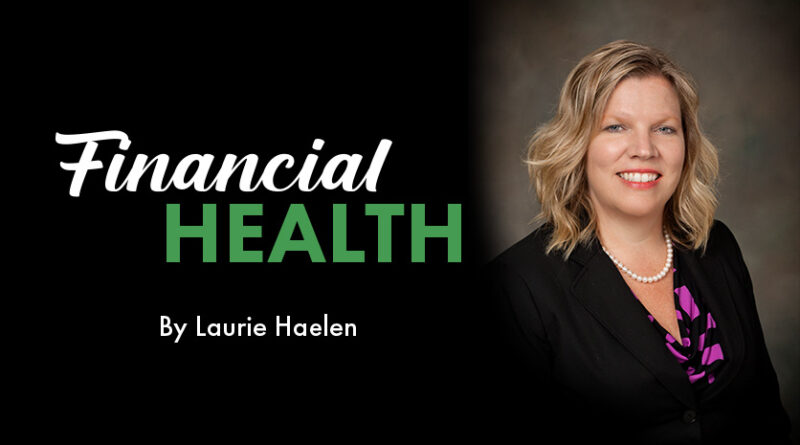New Year, New Financial You
By Laurie Haelen
When it comes to New Year’s resolutions, there seems to be two types of people: those who look forward to making (and sometimes breaking) them and those who think the whole thing is probably a waste of time.
Everyone knows that many popular resolutions are broken by the time Valentine’s Day comes around. Just look at the gym in January versus February or March!
However, I would argue that financial resolutions should be seriously considered for everyone.
I fully recognize that my long-time habit of tracking a balance sheet and cheering (or lamenting) its progress monthly is not for everyone. But this has given me the sense of financial security that I have today — even in the face of market volatility.
Getting started on financial resolutions at any time —New Year’s or not — can help bring peace of mind to both working and retired people if you tackle it in a few easy steps.
Step 1: Know where you stand by calculating your net worth.
For many, this may not be a challenge as you may already be a spreadsheet wizard or use an aggregator (i.e., MINT or Personal Capital) to regularly look at your balance sheet. For those who are new to the process, I would start by listing your assets including: home, investment accounts, bank accounts, loans, credit card balances, cash value of life insurance policies, 401k/403b, automobiles, home furnishings, vacation home or rentals. By subtracting debt from your assets, you end up with your total net worth.
The resolutions you should make may become clearer by regularly completing this exercise. As you look closely at your assets and liabilities, patterns may emerge. If you have low-interest savings accounts and high-interest debt, for example, a payoff strategy could be a top priority. Or, if your savings are not where they need to be, is there a way to save more? In the current environment, with both stocks and bonds “on sale” is there a way to put more money to work in the market?
Step 2: Rebalance your portfolio.
Volatility always creates opportunities, as the winners of last year are often the losers of today. Rebalancing your portfolio to your target allocation (such as 60% stocks, 40% bonds) will enable you to buy low and sell high —a proven long-term strategy for success. An annual rebalancing is preferable to a more frequent one, as studies show that rebalancing too often can increase taxes or fees and inhibit performance.
Step 3: Review your credit report.
Identity theft is running rampant. So checking your credit report is more important than ever. You are entitled to three free credit reports per year. In addition, many banks offer credit reporting that is free and daily.
There also are paid services that can help reduce the risk of someone opening accounts in your name or getting hold of passwords or other personal data.
If your credit score looks good and you can verify all the accounts as yours, then there is not much more to do than continue to monitor the data. If there are issues, however, take steps to improve your credit rating as it would adversely impact your ability to borrow by forcing you to get credit at a higher interest rate or not be able to get it when you need it.
Step 4: Review insurance coverage.
Insurance is a critical part of risk management and yet is an often-overlooked area of personal financial planning. At least annually, you should review all your coverage, including your property and casualty (homeowners, auto and umbrella), as well as your life insurance coverage.
It is possible that your coverage in any of these areas could be less or more than what you need, due to changing life circumstances. The cost, too, can rise so gradually that you may not realize how much more you are paying. If you have an agent or financial planner to assist with this, it can ameliorate the process. I have seen many circumstances with P&C insurance where clients could pay a lot less for even better coverage. Just don’t make a change based on cost alone, as you may end up with increased cost when you need the coverage due to an accident or catastrophic event.
Step 5: Set your budget for the year.
When setting the budget for the year, a good method is to first establish the minimum required for living expenses. With inflation as high as it has been recently, this amount could be higher for 2023. Therefore, you may need to cut back on some of the more enjoyable things, such as vacation, concerts, sporting events, etc.
Be sure to budget not just for spending but also for saving to ensure you have a comfortable emergency fund — as well as longer term investments for retirement or legacy needs and wants. If you are close to retirement, you may consider having a larger emergency fund accumulated for the first year of retirement, in case the market declines in that first year. By doing so, you can spend cash and leave the funds to recover in the market versus drawing them when it is down.
The new year is an excellent time to take a close look at your overall financial picture and take the necessary steps to re-chart your course if there are improvements to be made. If not, the peace of mind from knowing you are fiscally sound can put you in a positive frame of mind as you enter another year. Taking the time will always be a worthwhile resolution. So if there is one you will make, I recommend this one.

